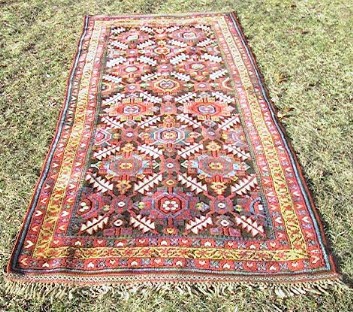
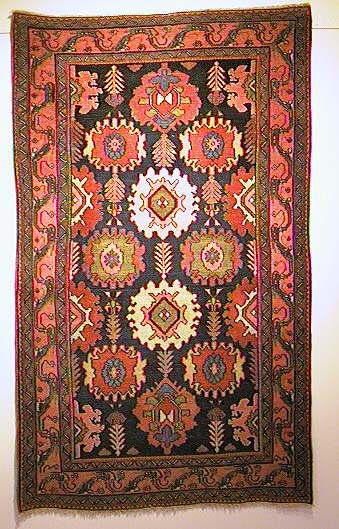
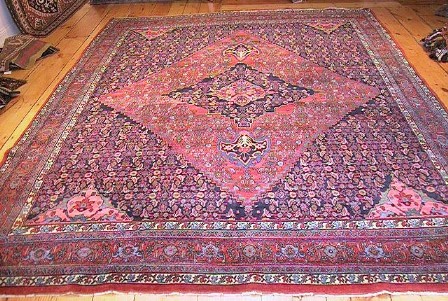

| Subject | : | Urban Kurdish |
| Author | : | Mike Tschebull |
| Date | : | 02-03-2000 on 08:07 a.m. |
tschebull@cshore.com
Before we leave (Iranian) Kurdistan, I'd like to discourse a bit about the
products of Kurdish urban areas. At least three carpet/rug designs that
seem to have been developed/popularized by designers working with
workshops in Kurdistan before the export boom became a factor throughout
Iran toward the end of the 19th century. They are 1) an architectural
layout garden design (See J. V. McMullan, "Islamic Carpets", plate 29), 2)
the Harshang, and 3) a repeat serrated leaf design. The first two - more
complex - should be familiar to most ruggies; the last is the only field
design used in pre-export Heriz-type carpets. Sotheby's NY had one of
these pre-export Herizes (illustrated) with a yellow field two sales ago.
The design concept is generally absent from the design vocabulary in older
rugs from the Heriz area, and must have been brought in. 



|
| Subject | : | RE:Urban Kurdish |
| Author | : | Deschuyteneer Daniel |
| Date | : | 02-03-2000 on 06:38 p.m. |
| Daniel Deschuyteneer Dear Mike, I don't know if you have noticed it but a similar piece as your Mahabad rug (same design and yellow ground main border) is illustrated in last Hali 108 page 104. I have handled a similar piece and thought considering it's palette of colors and red wefts that it could be from Sauj Bulaq. It contains also in the borders a vivid pink. Cordially, Daniel |
| Subject | : | RE:Urban Kurdish |
| Author | : | Mike+Tschebull |
| Date | : | 02-03-2000 on 10:06 p.m. |
| Yes, Daniel, I saw the Hali piece with the serrated leaf design. They're not too common. Most interesting in that rug is the main border, which also shows up in Heriz area small pile rugs. Now, where did that border come from? So far, I see no trace of it in older workshop carpets from the general area of the Caucausus or NW Iran. |
| Subject | : | RE:Urban Kurdish |
| Author | : | Michael Wendorf |
| Date | : | 02-03-2000 on 10:55 p.m. |
| Dear Mike and Daniel: The border on the Halidan piece advertised in Hali 108 seems to me to be derived from two different borders, the "S" like devices coming more out of the Caucasus or far northwest Iran and the so-called butterfly border in which the other device on the Haliden carpet's border is a flower attached to a common meander floral border in which the meandering vine forms an elongated "S"(a simplified and diminutive version of this border is the yellow border on the first image in Mike's post below). This border is almost always found on a group of large carpets with the mina khani design woven on a blue field and, what else, a yellow ground border. Jim Burns believes this mina khani group was woven around Songur. An example of the group was displayed in the exhibition I organized last fall. I think the images are still up. As for the serrated leaf design, the rug in Mike's image look like it has monster wool and a corrosive brown ground giving it that embossed feel of many Sauj Bulagh/Mahabad rugs. But I guess I have always thought of this serrated design as coming out of the many rugs with more naturally drawn leaves or what has been described variously as cypress, conifer or other trees creating in effect a lattice arounf the rosettes. Herrmann published a famous example in ATT Band 4 plate 64. A simple example on an ivory field with a rosette and shrub border was also in the exhibition I organized last fall. Kurds in particular seemed to enjoy exploring the possible uses of serrated edges and even used them to separate palmettes. An example is seen on Levi's cloudband section. This squarish piece labelled Jaf has a lot of reweaves but shows an interesting use of serrated edges to separate design elements. Certain rugs from the Sauj Bulagh area explore this as well. Mike's post states that the field design "is the only field design used in pre-export Heriz-type carpets" and then "the design concept is generally absent from the design vocabulary in older rugs from the Heriz area". These statements seem inconsistent, can you elaborate on what you mean? Thanks, Michael |
| Subject | : | RE:Urban Kurdish |
| Author | : | Guido Imbimbo |
| Date | : | 02-04-2000 on 06:51 a.m. |
| Dear All, I was interested by the Mike Tschebull post on the carpet designs developed by weavers working with workshop in Kurdistan. Regarding the third design type, Mike Tschebull asks from where does the "S" border of the Haliden's piece come from and Michael Wendorf elaborates about the origin of the "serrated leaves design". I would like to add some comment on both aspects. "S" border of Haliden's piece Other good examples of carpets that contain the Haliden border are: - Lot 3, Sotheby's NY, 15 Apr 1993 - Lot 68, Sotheby's NY, 22 Sept 1993 Michael Wendorf suggests that the "S" in the Haliden carpet comes from the Caucasus. It seems to me, instead, that the "S" is an elaboration deriving from the leaf design that is already present in this group of carpet. A very good example that seems to show this transformation is in the border of a carpet (with same serrated leaf field) appeared in Sotheby's LDN, 26 April 1995 (Lot 188). Another example is Lot 41, Sotheby's LDN, 25 July 1990. An earlier example of this "S"-leaf border is lot 27, Phillips LDN, 16 June 1992. A very similar carpet was published by Martin, History of Oriental carpets before 1800, and is date 1222-AD1807. Connection with Karadja design A connection between the "serrated leaves" device of the Tschebull carpet and design elements typical of carpets produced in an area more North West (Karadja) is represented by Lot 257, Sotheby's NY, 16 Dec 1998. This piece, attributed to Heriz, has the same serrated leaves field but it has a different main border design that is found typically in carpets attributed to the Karadja area. Note that the leaves in this carpet have a more naturalistic form. A further link between the "serrated leaves" motive and the Karadja patterns is a carpet of the Fisher collection (No 21 in the Dodds book). This piece is a very good (and rare) example of the connection between the Kurdish serrated leaves carpets group that we are discussing and the Karadja production. The field of the Fisher carpet contains the typical leaves but it also has two kinds of medallion that are a typical element of so called "Karadja" runners. One of these medallions was discussed in a previous Salon proposed by Daniel Deschuyteneer. The only published example similar to the Fisher piece (though of lower quality) is in Hali, 53 at pag. 1. Serrated leaves design Michael Wendorf commented about the origin of the serrated leaf design. Maybe it useful to notice that this pattern has been elaborated at least in two different forms. One with leaves with more natural design, the other whit leaves that have a more geometrical aspect (like those in the initial Tschebull post). Some examples of the two groups are listed below. Note that the carpets within the two groups vary considerably for quality and age. "Naturally" leaves design -page 200, Jourdan, Orientteppiche -Lot 10, Sotheby's NY, 17 Sept 1992 -Lot 56, Sotheby's LDN, 29 Apr. 1998 -Lot 37, Rippon Boswell, 11 May 1991 -No. 184, Sphuler, Carpets in the Berlin Museum, pag. 310 Semi-geometrical leaves -Lot 78, Rippon Boswell, 28 Mar 1992 -Hali 86, page 120 -Lot 228, Sotheby's, NY, 17 Sept. 1992 Thanks, guido |
| Subject | : | RE:Urban Kurdish |
| Author | : | Michael Wendorf |
| Date | : | 02-04-2000 on 10:32 p.m. |
| Dear Guido: Your posts plausibly suggests that the "S" element which I suggested derived from the Caucasus could be an elaboration deriving from the leaf design already present in this group of carpets. I do see the possible connection which is an interesting possibility. However, a number of much older 17th - 18 th century Caucasian or northwest persian carpets provide a counterpoint in support of my geographic attribution. For example, the so-called sunburst carpet belonging to the Textile Museum (R 36.2.12) published as plate 15 in Ellis' "Early Caucasian Rugs" shows a well drawn version of a border containing virtually the identical "S" forms alternating as on the Halidan carpet. Ellis makes the point that this border "offers the same alternation of two double-curved forms that is found in several dragon rugs, such as the Sharples carpet (see plate 139 in Yetkin's Early Caucasian Carpets) at the Philadelphia Museum of Art, as well as in other sunburst rugs." See page 60 of Early Caucasian Carpets. Of course, the place of manufacture of these sunburst carpets is a matter of some debate and Ellis also shows a few equally old carpets tentatively assigned to Hamadan or Kurdistan that have vaguely related border elements (see plate 51, the McIlheny Compartment and Tree Rug in Oriental Carpets from the Philadelphia Museum of Art). But some of the earliest dragon rugs also have a varicolored vine composed alternately of "S" forms and diagonally placed palmettes. I could see how the border we are discussing could be interpreted as a simplified version of such borders, e.g. plate 7 in Early Caucasian Rugs,the dragon rug in the Burrell Collection in Glasgow 9/38 or the Joseph Lees Williams dragon rug in Philadelphia plate 53 In Oriental Carpets. None of this means that the "S" element could not be an elaboration deriving from the leaf design already present in this group as you suggest. However, in comparing the border to Caucasian references it is at least equally likely that the "S" form detached and alternating on the Haliden rug is derived from vining on these earlier rugs. I think this explanation is more consistent with the popular border formats of rosettes, palmettes and vining evolved over many, many generations. Thank you, Michael Wendorf |
| Subject | : | Border detail, 4ƌ |
| Author | : | Mike Tschebull |
| Date | : | 02-05-2000 on 08:12 a.m. |
tschebull@cshore.com
I'm guessing that if you had the time and the free access to all the old
Caucasian-like carpets stored in Turkish museum vaults, you'd find the
border in question, only better drawn and more complex. Of course, those
precise "S" forms are common elements in old "Caucasian" carpet borders
(see Yetkin, Ellis), and are often part of a meander, but in those vaults,
I'd be looking for a border with large upright "S" forms combined with the
element used in the "Gohar" carpet (See plate 3, "Weavers, Merchants and
Kings"). The border is fairly rare in 19th century village rugs, and
doesn't pop up in "boom" carpet borders, as far as I'm aware. But it does
appear in smallish rugs from Kurdistan, East Azarbayjan (see detail of a
"Bakshaish" border) and, probably, the eastern Caucasus (see p. 37, Hali
107). 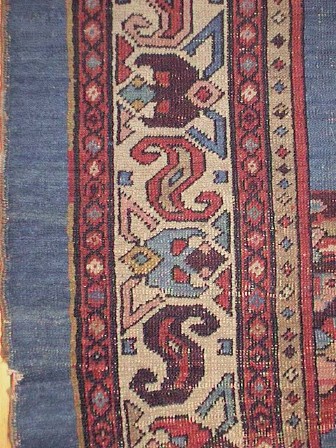 The wide
distribution makes me think the border has a long history. I don't see a
direct relationship with the yellow border around those blue-field Mina
Khani long rugs. Same school, different classroom. The serrated leaf
design rug I put up has full pile - something pretty uncommon for this
group of rug, I think. Most unusual is that the light blue seems to be all
mohair. The rug has a dark brown corroded field. On the basis of color
alone, it wouldn¹t take much to convince me that those large "Kurdish"
garden carpets came from Mahabad also. Herrmann ATT Band IV, plate 64 is
the pre-export Heriz design I'm talking about. That particular carpet is
almost certainly from East Azarbayjan, not Kurdistan. (For more on this,
see my article in Hali 90 on Heriz weaving.) There have been a number of
these yellow field serrated-leaf carpets on the market recently, flushed
out by the high price the Herrmann/LeFevre piece brought. I'm sure we'll
see more. Sorry about what seems an inconsistency re Heriz-type design.
(It's hard to write this kind of material up, put it right out on the Web,
and have it make perfect sense. Better to let it gestate a bit.) That
serrated leaf design is almost completely absent in pre-export East
Azarbayjani village pile weaving - small rugs, kennereh, kellegi - as near
as I can tell, and only appears in those long, presumably 19th century,
so-called gallery carpets with yellow or ivory fields. So, I can surmise
the design came from the south, where it was apparently more commonly
used. By the way, the serrated leaf field design must have its ancestry
with the so-called "Bird" rug pattern from western Turkey. It's worth
noting that both the Azarbayjani and Turkish versions are woven on light
fields. And it must be mentioned that a version of the same leaf is a very
old border motif. Those serrated leaves as a field design do look like
cypresses, but I think they're just more elegantly drawn serrated leaves,
reflecting a workshop ancestry. This more elegant version shows up on
wool-foundation, fine, floppy Kurdish kellegi, often with blue fields.
That group of Kurdish rugs can have tree motives and very complex borders.
I wonder where they're from? To really find out requires a trip to West
Azarbayjan. The Dennis Dodds reference - plate 21, Fisher Collection -
sure looks like a 19th century Qarajeh rug, and the colors and structure
are right, too. I've not seen those Kurdish-style leaves in such rugs, but
that's part of the fun of being a rug collector. Qarajeh is a beautiful
remote small village about 3 km off the Tabriz-Ahar road, maybe 200 years
old. As I've said before, most of the village inhabitants of the area are
believed to be Turkisized Kurds. I hope this adds something to the
discussion of Kurdish pile weaving. The wide
distribution makes me think the border has a long history. I don't see a
direct relationship with the yellow border around those blue-field Mina
Khani long rugs. Same school, different classroom. The serrated leaf
design rug I put up has full pile - something pretty uncommon for this
group of rug, I think. Most unusual is that the light blue seems to be all
mohair. The rug has a dark brown corroded field. On the basis of color
alone, it wouldn¹t take much to convince me that those large "Kurdish"
garden carpets came from Mahabad also. Herrmann ATT Band IV, plate 64 is
the pre-export Heriz design I'm talking about. That particular carpet is
almost certainly from East Azarbayjan, not Kurdistan. (For more on this,
see my article in Hali 90 on Heriz weaving.) There have been a number of
these yellow field serrated-leaf carpets on the market recently, flushed
out by the high price the Herrmann/LeFevre piece brought. I'm sure we'll
see more. Sorry about what seems an inconsistency re Heriz-type design.
(It's hard to write this kind of material up, put it right out on the Web,
and have it make perfect sense. Better to let it gestate a bit.) That
serrated leaf design is almost completely absent in pre-export East
Azarbayjani village pile weaving - small rugs, kennereh, kellegi - as near
as I can tell, and only appears in those long, presumably 19th century,
so-called gallery carpets with yellow or ivory fields. So, I can surmise
the design came from the south, where it was apparently more commonly
used. By the way, the serrated leaf field design must have its ancestry
with the so-called "Bird" rug pattern from western Turkey. It's worth
noting that both the Azarbayjani and Turkish versions are woven on light
fields. And it must be mentioned that a version of the same leaf is a very
old border motif. Those serrated leaves as a field design do look like
cypresses, but I think they're just more elegantly drawn serrated leaves,
reflecting a workshop ancestry. This more elegant version shows up on
wool-foundation, fine, floppy Kurdish kellegi, often with blue fields.
That group of Kurdish rugs can have tree motives and very complex borders.
I wonder where they're from? To really find out requires a trip to West
Azarbayjan. The Dennis Dodds reference - plate 21, Fisher Collection -
sure looks like a 19th century Qarajeh rug, and the colors and structure
are right, too. I've not seen those Kurdish-style leaves in such rugs, but
that's part of the fun of being a rug collector. Qarajeh is a beautiful
remote small village about 3 km off the Tabriz-Ahar road, maybe 200 years
old. As I've said before, most of the village inhabitants of the area are
believed to be Turkisized Kurds. I hope this adds something to the
discussion of Kurdish pile weaving. |
| Subject | : | RE:Urban Kurdish |
| Author | : | Michael Wendorf |
| Date | : | 02-05-2000 on 05:23 p.m. |
Dear Friends: A series of photos of Kurdish rugs from a recent
exhibition can be found at http://www.orientalcarpets.net/Exhibition_of_Kurd_rugs.htm
In particular, one shows a rare and very old long carpet on an ivory
ground with a distinctive rosette and shrub border. 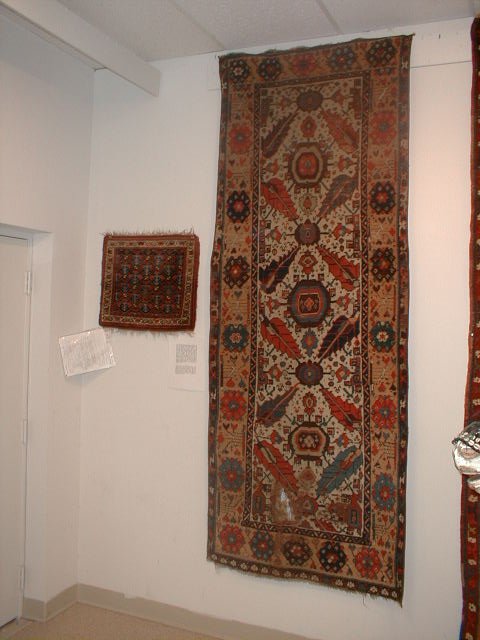 As Mike points out, here the
serrated element seems to be more clearly a leaf rather than a cypress or
conifer. Still there seem to be several basic design varients within the
basic type we are discussing, some of which could be cypress or other
trees. The cypress also seems plausible because it was a popular tree in
the formal persian garden that so influenced Persian weaving. On the other
hand, cypress trees are likely one of the design elements found in another
pattern popular in Kurdistan, the weeping willow or Bid Majnun pattern and
there they look different than the serrated element we are discussing. I
am not certain about the workshop ancestry of the serrated leaf as
referred to by Mike. In the same exhibition was a group of four related
rugs with ivory fields, the rosette and shrub border. Two different field
designs are used in this group - the serrated leaf design and a
pan-persian all over floral design (I am also aware of a fifth example
with serrated leaves in a west coast collection). The rugs in this groupo
seem to have been made over a fairly lengthy time period, perhaps the
early to late 19th century. The later examples do seem more workshop like
in the drawing, color, wefting and materials - but the rug with the
serrated leaf design had a more tribal feel to it including very erratic
wefting. The whole group can be seen at
www.orientalcarpets.net/images/kurd0006.jpg. Judge for yourselves. I also
mentioned that in some Kurdish weavings serrated leaves are used almost
like a ground or second plane of design to separate other design units,
usually palmettes. A Sauj Bulagh area rug in the exhibition demonstrates
this - As Mike points out, here the
serrated element seems to be more clearly a leaf rather than a cypress or
conifer. Still there seem to be several basic design varients within the
basic type we are discussing, some of which could be cypress or other
trees. The cypress also seems plausible because it was a popular tree in
the formal persian garden that so influenced Persian weaving. On the other
hand, cypress trees are likely one of the design elements found in another
pattern popular in Kurdistan, the weeping willow or Bid Majnun pattern and
there they look different than the serrated element we are discussing. I
am not certain about the workshop ancestry of the serrated leaf as
referred to by Mike. In the same exhibition was a group of four related
rugs with ivory fields, the rosette and shrub border. Two different field
designs are used in this group - the serrated leaf design and a
pan-persian all over floral design (I am also aware of a fifth example
with serrated leaves in a west coast collection). The rugs in this groupo
seem to have been made over a fairly lengthy time period, perhaps the
early to late 19th century. The later examples do seem more workshop like
in the drawing, color, wefting and materials - but the rug with the
serrated leaf design had a more tribal feel to it including very erratic
wefting. The whole group can be seen at
www.orientalcarpets.net/images/kurd0006.jpg. Judge for yourselves. I also
mentioned that in some Kurdish weavings serrated leaves are used almost
like a ground or second plane of design to separate other design units,
usually palmettes. A Sauj Bulagh area rug in the exhibition demonstrates
this -  Finally an image of a
member of the mina khani group of blue field rugs with yellow meander
border forming an elongated "S" I referred to earlier is represented by
image 0013 in the same exhibition. Finally an image of a
member of the mina khani group of blue field rugs with yellow meander
border forming an elongated "S" I referred to earlier is represented by
image 0013 in the same exhibition.  No one has taken a stab at the Kurdish village carpet with the
undyed beige ground. I have always understood conventional wisdom to be
that these come from around Bidjar due I guess to a structural
relationship with Bidjars. I have never found this to be particularly
compelling but have no good alternative in mind. So Mike, do you know? I
hope this adds something to our discussion. Michael No one has taken a stab at the Kurdish village carpet with the
undyed beige ground. I have always understood conventional wisdom to be
that these come from around Bidjar due I guess to a structural
relationship with Bidjars. I have never found this to be particularly
compelling but have no good alternative in mind. So Mike, do you know? I
hope this adds something to our discussion. Michael |
| Subject | : | RE:Persian Kurd Rugs |
| Author | : | Michael Wendorf |
| Date | : | 02-05-2000 on 11:10 p.m. |
Dear Friends: Further to my last post, there is another Kurdish
serrated leaf long rug of a type related to the long rug seen in my last
post. An example was advertised in Hali 86 at page 120. This particular
rug, though heavily restored and probably missing its outer border, has
the second and more Caucasian feeling main border I have seen used on rugs
with this design and an ivory field. These long rugs do not seem to have
been made near Sauj Bulagh or Mahabad in contrast to the less
natualistically drawn first example posted by Mike Tschebull with the
corrosive brown field. Rather the ivory ground rugs all seem to come from
another part of Persian Kurdistan. As stated earlier, I am uncertain about
the workshop ancestry of the earliest examples. In my mind, the most
interesting of these all have the rosette and shrub border that is a
direct descendent of a border otherwise seen only on formal Kurdistan
garden carpets (the J.V. McMullan example from Islamic Carpets primary
among these). I handled five long rugs with this border and have two in my
collection including the serrated leaf example seen in the previous post.
Four were hung side by side in a recent exhibition: 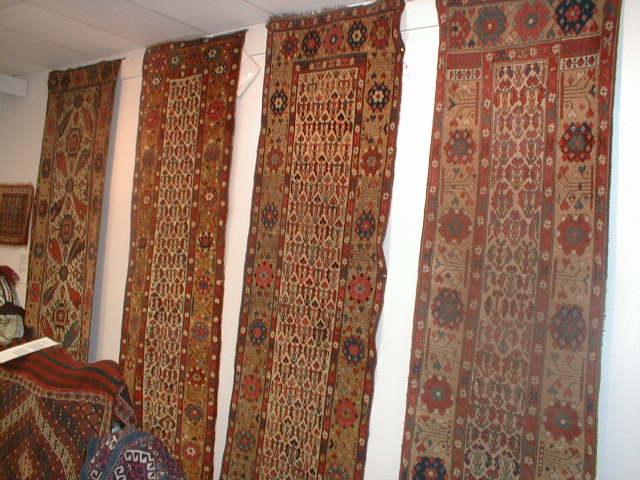 Thus we see a number of related
rugs from several different Kurdish sources all exploring the same theme.
I think this supports Mike Tschebull's statement that this serrated leaf
design was developed/popularized by designers in workshops in Kurdistan
though I think we might go further and say this is a Kurdish design that
became further popularized among designers adapting Kurdish designs in
workshops over much of the 19th century. I will stop now, hope this adds
something. -Michael Thus we see a number of related
rugs from several different Kurdish sources all exploring the same theme.
I think this supports Mike Tschebull's statement that this serrated leaf
design was developed/popularized by designers in workshops in Kurdistan
though I think we might go further and say this is a Kurdish design that
became further popularized among designers adapting Kurdish designs in
workshops over much of the 19th century. I will stop now, hope this adds
something. -Michael |
| Subject | : | RE:Persian Kurd Rugs |
| Author | : | Deschuyteneer Daniel |
| Date | : | 02-06-2000 on 06:05 a.m. |
| Dear all, The rug illustrated in Jon Thompson “Carpet Magic” book page 39 is an interesting related rug. It shares with Mike’s Bibikabad rug and his third Kurdish rug of indeterminate origin somewhat the same motifs and shares with Michael Sauj Bulaq Kurdish rug (second picture in his post) the same unusual main border. The three rugs have a similar color palette. A Turkish dealer once had on his web site a similar rug as Michael Sauj Bulaq rug and thought it could have been woven by the Herki tribe. Another rug, probably miss attributed, and closely related to Michael Sauj Bulaq rug is a Dodds’ rug illustrated as plate 111 in Oriental Rugs from Atlantic Collections. Cordially, Daniel |
| Subject | : | RE:Urban Kurdish |
| Author | : | Michael Wendorf |
| Date | : | 02-06-2000 on 09:05 a.m. |
| Dear Daniel: You are correct about the border of the rug on page 39 of Thompson's Carpet Magic (some readers may know this book as Oriental Carpets From the Tents, Cottages and Workshops of Asia) and my Sauj Bulagh/Mahabad rug posted above. The design orientations of what appear to be rosettes also seem to have a relationship with rugs 2 and 3 of Mike's initial post, if only in lay out. If we look at the rug on page 39 of Carpet Magic you will see that the flowers are really of three distinct types - they are the flowers or rosettes found on the classic persian mina khani pattern enlarged to dominate the entire field and omitting the distinctive small white flowers usually found on the pattern. The vining which is usually on two planes and on which these flowers or rosettes usally appear is minimized. Look at the image of the blue ground long rug with the yellow border 3 posts above this one for a more classic version of the mina khani pattern. Incidently, the mina khani pattern is assumed to be a Kurdish pattern, but we see it used all over Persia and even by Ersaris. This seems different than the two rugs Mike posted. The Bibi has two flowers that vaguely seem related to flowers found on the Avshan pattern, the Kurd rug from some where in NWP uses undyed beige wool, very unusual, with what appears to be one floral form changed only through use of color, though here too there is a hint of an internal pattern by the way the weaver alternates pink and blue and green and red rosettes in the field. Kurdish weavers loved exploring pattern through repetition broken only by color juxtapostion; in fact Jaf weavings raise this exploration to remarkable heights in the best examples. As for the border on the rug from Carpet Magic, I thought for a long time that this was an Anatolian side border, but I have no seen it enough on the Iranian side to believe it was used incorporated there early on. My Sauj Bulagh rug with this border seen above is on a completely corroded ground. There is a connection with the Dodds rug from Atlantic Collections, but as we have discussed previously that rug is on a different ground and has a different palette. At least 4 other examples of the same group my rug comes from are known, unfortunately unpublished. In terms of Kurdish village weaving, one observation I have made is that if you learn to identify the individual design elements of the avshan, harshang, bid majnun, herati and mina khani patterns, you see these elements appear in various ways appear in simplified form in these rugs. Going back to the group of ivory ground long rugs with rosette and shrub border, there is another rug (again heavily restored) on page 46 of Carpet Magic with floral or shrub forms on an ivory field and a cartouche type border. The design on this old rug may be related to the second design found on the group of long rugs shown above. I think we can start to talk about Kurdish designs when we see such distinctive groups. On the otherhand, one can find the floral device found on three of the four long rugs in the photo above on a variety of weavings scattered throughout Persia. In any event, I believe that the creativity and influence of Kurdish weavers and workshops is severely underestimated in the rug world. Thank you, Michael |
| Subject | : | RE:Urban Kurdish |
| Author | : | Steve Price |
| Date | : | 02-06-2000 on 09:18 a.m. |
| sprice@hsc.vcu.edu
Dear People, First, here's an image of a rug to which Michael Wendorf
referred in his response to Guido Imbimbo earlier in this thread. |
| Subject | : | RE:Urban Kurdish |
| Author | : | Daniel Deschuyteneer |
| Date | : | 02-07-2000 on 08:35 a.m. |
daniel.d@infonie.beDear
all, I think that the following pictures and comments can help in this
discussion.  From left to
right: 1/ picture SNY 12/98 - Lot 257 - Heriz runner (470cm x 96cm) -
Guido’s comments : “A connection between the "serrated leaves" device of
the Tschebull carpet and design elements typical of carpets produced in an
area more North West (Karadja) is represented by Lot 257, Sotheby's NY, 16
Dec 1998. This piece, attributed to Heriz, has the same serrated leaves
field but it has a different main border design that is found typically in
carpets attributed to the Karadja area. Note that the leaves in this
carpet have a more naturalistic form.“ 2/ Hali 108 - Haliden rug Mike
Tshebull comments: Most interesting in that rug is the main border, which
also shows up in Heriz area small pile rugs. Now, where did that border
come from? So far, I see no trace of it in older workshop carpets from the
general area of the Caucausus or NW Iran. 3/ -Lot 56, Sotheby's LDN, 29
Apr. 1998 - "Naturally" leaves design Guido comments: Michael Wendorf
commented about the origin of the serrated leaf design. Maybe it useful to
notice that this pattern has been elaborated at least in two different
forms. One with leaves with more natural design, the other whit leaves
that have a more geometrical aspect (like those in the initial Tschebull
post). This piece is on display at the Brussel Antique Fair and I handled
it yesterday. This rug is a very nice floppy long runner, woven with
lustrous long wool pile, measuring 322 cm x 103 cm. It’s structure is
similar to many so called Karadagh - Azerbaidjian rugs. It has 3 ply ivory
fine wool warps, 4 to 6 white cotton (perhaps wool - the rug hangs on a
wall and couldn’t be easily examined) wefts between each rows of knots, a
flat back and is coarsely woven with symmetrical knots. Colors are natural
: ivory, various blue, corrosive brown, light orange and red shades,
saffron yellow, pink, and a very nice aubergine. 4/ Mike Tschebull rug :
leaves that have a more geometrical aspect Two other references of related
rugs with “naturalistic” leaves are: From left to
right: 1/ picture SNY 12/98 - Lot 257 - Heriz runner (470cm x 96cm) -
Guido’s comments : “A connection between the "serrated leaves" device of
the Tschebull carpet and design elements typical of carpets produced in an
area more North West (Karadja) is represented by Lot 257, Sotheby's NY, 16
Dec 1998. This piece, attributed to Heriz, has the same serrated leaves
field but it has a different main border design that is found typically in
carpets attributed to the Karadja area. Note that the leaves in this
carpet have a more naturalistic form.“ 2/ Hali 108 - Haliden rug Mike
Tshebull comments: Most interesting in that rug is the main border, which
also shows up in Heriz area small pile rugs. Now, where did that border
come from? So far, I see no trace of it in older workshop carpets from the
general area of the Caucausus or NW Iran. 3/ -Lot 56, Sotheby's LDN, 29
Apr. 1998 - "Naturally" leaves design Guido comments: Michael Wendorf
commented about the origin of the serrated leaf design. Maybe it useful to
notice that this pattern has been elaborated at least in two different
forms. One with leaves with more natural design, the other whit leaves
that have a more geometrical aspect (like those in the initial Tschebull
post). This piece is on display at the Brussel Antique Fair and I handled
it yesterday. This rug is a very nice floppy long runner, woven with
lustrous long wool pile, measuring 322 cm x 103 cm. It’s structure is
similar to many so called Karadagh - Azerbaidjian rugs. It has 3 ply ivory
fine wool warps, 4 to 6 white cotton (perhaps wool - the rug hangs on a
wall and couldn’t be easily examined) wefts between each rows of knots, a
flat back and is coarsely woven with symmetrical knots. Colors are natural
: ivory, various blue, corrosive brown, light orange and red shades,
saffron yellow, pink, and a very nice aubergine. 4/ Mike Tschebull rug :
leaves that have a more geometrical aspect Two other references of related
rugs with “naturalistic” leaves are: 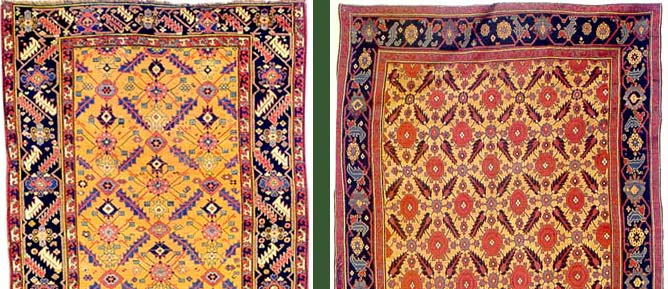 Left : Sotheby’s New York 08/10/99 - lot 267 Sotheby’s comments:
Azerbaijan gallery carpet - Northwest Persia/South Caucasus 457 cm X 180
cm (15’ x 5411”) For related examples please refer to SNY 10/04/1997 - lot
237 - also published by Raoul Tschebull, “Heriz: A Historical Perspective
- Hali issue 90 plate 16 and Herrmann Asiatische Teppich-und Textilkunst-
Munich 1992- and SNY 01/10/1998 - lot 333 Hali 108 page 127 comments:
Early 20th century North West Persian kelleh. This carpet is related to a
group of yellow ground East Azerbaiyan carpets that are nearly all at
least twice as long as they are wide. Several have been on tha market
recently, including a much rarer white ground piece deaccessioned by
Winterthur in 1996 (Hali 91 page 156). Arguably the oldest example was (a
yellow ground lattice carpet sold at Lefevre in 1979, published by
Herrmann in 1993 (ATT band 4 plate 64) and then sold (again) by SNY in
april1997 (Hali 93 page 127)… The present carpet… has the same field
design, in a slightly more cluttered fashion, as the other examples, but
with borders that seem to be more late 19th century than circa 1800 as the
catalogue suggests. Cotton wefts add credence to a late 19th century
dating. The inwoven date panel does little to help as it can be read as
1906, 1956 or even 2591. Right: Sotheby’s New York 01/10/98 - lot 333
First quarter 19th century - 528 cm x 279 cm (17’4” x 12’) Hali 103 page
139 comments: It is a pre-export carpet from East Azerbaijan, meant to be
used in long narrow communal rooms in local houses of the well born or
well to do. The foundation is all cotton. The design and colours of this
carpet and the - “(Lefevre in 1979, published by Herrmann in 1993 and then
sold (again) by SNY in april1997 (Hali 93 page 127))” - are so close that
the two carpets must have come from the same production facility. Of
course this piece is crowded by comparison. Dating could be as early as
1800, but is more likely to be somewhat later. Cordially,
Daniel Left : Sotheby’s New York 08/10/99 - lot 267 Sotheby’s comments:
Azerbaijan gallery carpet - Northwest Persia/South Caucasus 457 cm X 180
cm (15’ x 5411”) For related examples please refer to SNY 10/04/1997 - lot
237 - also published by Raoul Tschebull, “Heriz: A Historical Perspective
- Hali issue 90 plate 16 and Herrmann Asiatische Teppich-und Textilkunst-
Munich 1992- and SNY 01/10/1998 - lot 333 Hali 108 page 127 comments:
Early 20th century North West Persian kelleh. This carpet is related to a
group of yellow ground East Azerbaiyan carpets that are nearly all at
least twice as long as they are wide. Several have been on tha market
recently, including a much rarer white ground piece deaccessioned by
Winterthur in 1996 (Hali 91 page 156). Arguably the oldest example was (a
yellow ground lattice carpet sold at Lefevre in 1979, published by
Herrmann in 1993 (ATT band 4 plate 64) and then sold (again) by SNY in
april1997 (Hali 93 page 127)… The present carpet… has the same field
design, in a slightly more cluttered fashion, as the other examples, but
with borders that seem to be more late 19th century than circa 1800 as the
catalogue suggests. Cotton wefts add credence to a late 19th century
dating. The inwoven date panel does little to help as it can be read as
1906, 1956 or even 2591. Right: Sotheby’s New York 01/10/98 - lot 333
First quarter 19th century - 528 cm x 279 cm (17’4” x 12’) Hali 103 page
139 comments: It is a pre-export carpet from East Azerbaijan, meant to be
used in long narrow communal rooms in local houses of the well born or
well to do. The foundation is all cotton. The design and colours of this
carpet and the - “(Lefevre in 1979, published by Herrmann in 1993 and then
sold (again) by SNY in april1997 (Hali 93 page 127))” - are so close that
the two carpets must have come from the same production facility. Of
course this piece is crowded by comparison. Dating could be as early as
1800, but is more likely to be somewhat later. Cordially,
Daniel |
| Subject | : | RE:Urban Kurdish |
| Author | : | Deschuyteneer Daniel |
| Date | : | 02-08-2000 on 09:42 a.m. |
| Dear all, Many Luri rugs have a somewhat similar lay out as the rugs illustrated here with a lattice of similar serrated leaves forming lozenges containing similar shrubs of flowers in various colors as those seen between the palmettes in the main borders of Michael rugs. One of these rugs is illustrated in Hali 99 page 142. Some author’s state also that the Lurs have a common Kurdish ancestry. As Kurdish weavers are well known to copy and adapt designs from their neighbours I guess that one possible origin for the rugs discussed here is that they were woven in towns and villages of Persian South Kurdistan being adjacent to the NW Persian Lori area. It’s just a guess … Cordially, Daniel |
| Subject | : | RE:Urban Kurdish |
| Author | : | Patrick Weiler |
| Date | : | 02-08-2000 on 11:02 p.m. |
| jpweil00@gte.net Daniel, I have another rug to throw into the mix. I
would call it Hamadan, not Kurdish. It has a serrated leaf lattice in a
more natural form. |
| Subject | : | RE:Urban Kurdish |
| Author | : | Patrick+Weiler |
| Date | : | 02-08-2000 on 11:45 p.m. |
jpweil00@gte.net Well, Try # 2 at inserting image URL's into a
message: The Hamadan:  The
"S" border: The
"S" border:  The back,
showing single wefts: The back,
showing single wefts: 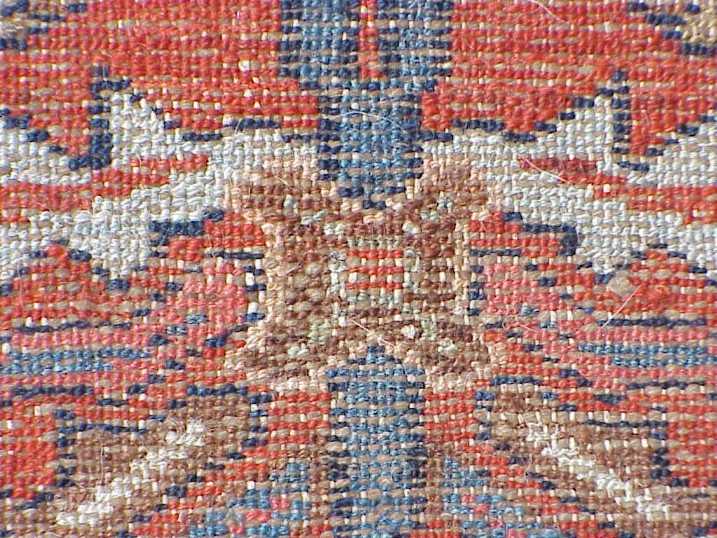 And,
finally, THE BIRDS!: And,
finally, THE BIRDS!: 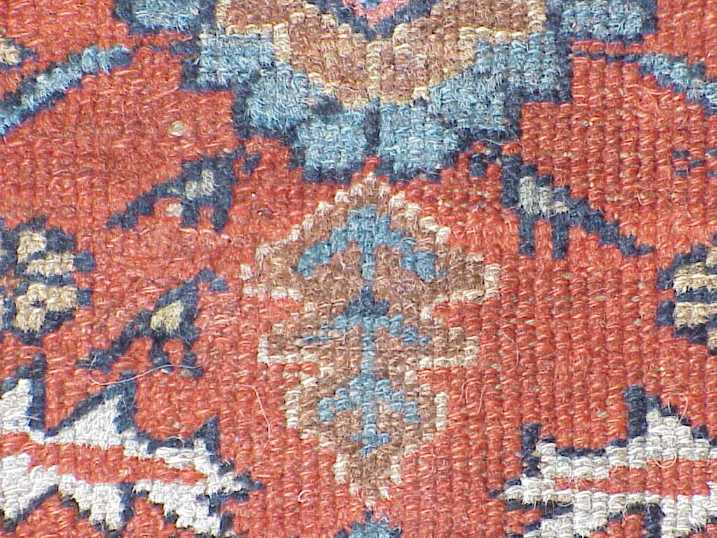 |
| Subject | : | RE:Urban Kurdish |
| Author | : | Daniel Deschuyteneer |
| Date | : | 02-09-2000 on 05:56 a.m. |
| Dear all, Reading Cecil Edward “The Persian Carpet” book is always a source of interesting information. The pattern with the serrated leaves and rosette which appears in Mike’s and Michael’s rugs as well as in a lot of other rugs presented during this Salon is known as the Gol Henaï Pattern. Cecil Edwards in his chapter “Some notes on design”, page 49, comments the Gol Henaï Pattern illustrated in plate 34 – page 50 – as follow: Commentators have frequently stated that this small repeating pattern is named after the Henna plant, which it does not much resemble. Gol Henaï is however, also used to denote the Garden Balsam, which the pattern does suggest. Although it is a well-known pattern in Persia, it is not widely spread. It appears to have originated in Arak (Sultanabad) and it is still one of the most common patterns used by the weavers of the Mushkabad and Mahal qualities. In the west the design is frequently called the chestnut pattern, because it recalls the blossom of the horse chestnut. Thanks, Daniel |
| Subject | : | RE:Urban Kurdish |
| Author | : | Mike Tschebull |
| Date | : | 02-09-2000 on 08:23 a.m. |
tschebull@cshore.com
On a closer look, it seems reasonable to assume that the Haliden border
shows an intermediate stage of decomposition of a formal carpet border,
the type I think may be found on large carpets from the "Dragon" rug era,
and that the "Butterfly" border seen on the blue-field Mina Khani Kurdish
rugs represents further "degeneration" of the same. It's true that the
Mahabad rug I showed has a guard border that more or less has the same
look and color as the butterfly border, but it is a stretch to say that
such a ubiquitous, simple, and narrow guard owes much to what I think is a
formal carpet border. The Haliden border is not as well-drawn as the
Bakshaish detail I showed nor the Caucasian rug border in the last Hali,
so I can assume, upstream, there's a better drawn version - maybe not in
the Turk ve Islam - but something more complex. These Mina Khani rugs with
yellow borders are not that uncommon - and are remarkably alike. The
design must have been stable for some time - or, the rugs were produced in
one burst over a short period of time. A simple(?) good organic test for
age would answer that question. 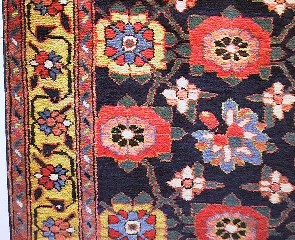 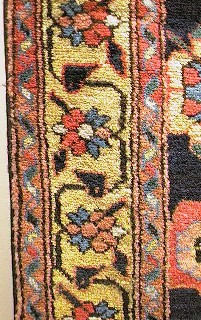 The images shown here are
from a 22' long example. I know of one pair of similar kennereh clearly
dated 1271 that look very much like the twenty-two footer. It is
interesting that this design style seems to appear only in a kennereh
format. (Watch this post flush out a 12X18 version!) The "Butterfly"
border is sometimes used on small rugs from East Azarbayjan and Qarabagh.
Thank you, Daniel, for putting up all those pictures. The runner "Heriz"
from SNY, 1998, with the overall serrated leaf design is the only common
version of this pattern in "Heriz" export rugs, and such runners are
almost always quite late. For some unexplained reason,
overall-serrated-leaves wasn't used on Sarapis and Herizes for export.
Now, as to that camel-colored rug Michael asks about, it is probably a
so-called "Kurd Bijar". It has typical K-B 2ZS beige wool warps, beige
winder wool wefts X1, and thick red selvedges. The colors and pattern are
atypical; most K-Bs have orthodox coloring. Kurd Bijars are often
undervalued in the market. The images shown here are
from a 22' long example. I know of one pair of similar kennereh clearly
dated 1271 that look very much like the twenty-two footer. It is
interesting that this design style seems to appear only in a kennereh
format. (Watch this post flush out a 12X18 version!) The "Butterfly"
border is sometimes used on small rugs from East Azarbayjan and Qarabagh.
Thank you, Daniel, for putting up all those pictures. The runner "Heriz"
from SNY, 1998, with the overall serrated leaf design is the only common
version of this pattern in "Heriz" export rugs, and such runners are
almost always quite late. For some unexplained reason,
overall-serrated-leaves wasn't used on Sarapis and Herizes for export.
Now, as to that camel-colored rug Michael asks about, it is probably a
so-called "Kurd Bijar". It has typical K-B 2ZS beige wool warps, beige
winder wool wefts X1, and thick red selvedges. The colors and pattern are
atypical; most K-Bs have orthodox coloring. Kurd Bijars are often
undervalued in the market. |